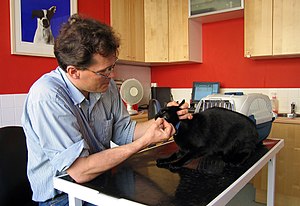Veterinary medicine

Veterinary medicine is the application of medical, diagnostic, and therapeutic principles to companion, domestic, exotic, wildlife, and production animals. Veterinary science is vital to the study and protection of animal production practices, herd health and monitoring the spread of disease. It requires the acquisition and application of scientific knowledge in multiple disciplines and uses technical skills directed at disease prevention in both domestic and wild animals. The Egyptian Papyrus of Kahun (1900 BCE) and literature of the Vedic period in India offer the first written records of veterinary medicine.[2] One of the edicts of Ashoka reads: "Everywhere King Piyadasi (Asoka) erected two kinds of hospitals, hospitals for people and hospitals for animals. Where there were no healing herbs for people and animals, he ordered that they be bought and planted."[1]
Veterinary science helps human health through the careful monitoring of livestock, companion animal and wildlife health. Emerging zoonotic diseases around the globe require capabilities in epidemiology and infectious disease surveillance and control that are particularly well-suited to veterinary science's "herd health" approach.

Veterinary medicine is informally as old as the human/animal bond but in recent years has expanded exponentially because of the availability of advanced diagnostic and therapeutic techniques for most species. Animals nowadays often receive advanced medical, dental, and surgical care including insulin injections, root canals, hip replacements, cataract extractions, and pacemakers.
Veterinary specialization has become more common in recent years. Currently 20 veterinary specialties are recognized by the American Veterinary Medical Association (AVMA), including anesthesiology, behavior, dermatology, emergency and critical care, internal medicine, cardiology, oncology, ophthalmology, neurology, radiology and surgery. In order to become a specialist, a veterinarian must complete additional training after graduation from veterinary school in the form of an internship and residency and then pass a rigorous examination.
Veterinarians assist in ensuring the quality, quantity, and security of food supplies by working to maintain the health of livestock and inspecting the meat itself. Veterinary scientists occupy important positions in biological, chemical, agricultural and pharmaceutical research.
In many countries, equine veterinary medicine is also a specialized field. Clinical work with horses involves mainly locomotor and orthopedic problems, digestive tract disorders (including equine colic, which is a major cause of death among domesticated horses), and respiratory tract infections and disease.
Zoologic medicine, which encompasses the healthcare of zoo and wild animal populations, is another veterinary specialty that has grown in importance and sophistication in recent years as wildlife conservation has become more urgent.

As in the human health field, veterinary medicine (in practice) requires a diverse group of individuals to meet the needs of patients. In the USA, veterinarians must complete four years of study in a veterinary school following 3–4 years of undergraduate pre-veterinary work. They then must sit for a national examination as well as examinations in those states in which they wish to become licensed practitioners. Veterinarians are expected to diagnose and treat disease in a variety of different species without benefit of verbal communication with their patients. In addition to veterinarians, many veterinary hospitals utilize a team of veterinary technicians and veterinary assistants to provide care for sick as well as healthy animals. Veterinary technicians are, essentially, veterinary nurses and are graduates of two or four year college-level programs and are legally qualified to assist veterinarians in many medical procedures. Veterinary assistants are not licensed by most states, but can be well-trained through programs offered in a variety of technical schools.
Notes
References
- Thrusfield, Michael (2007). Veterinary Epidemiology. Blackwell Publishing. ISBN 1405156279.
- Finger, Stanley (2001). Origins of Neuroscience: A History of Explorations Into Brain Function. US: Oxford University Press. ISBN 0195146948.
See also
- Cattle Health Initiative (British)
External links
- Consultant Online computer-assisted veterinary diagnosis
- Association of American Veterinary Medical Colleges, Web site for all U.S. and Canadian veterinary medical schools, and for other AVMA-accredited veterinary schools worldwide (also administers vet school application site)
- American Veterinary Medical Association (AVMA) Official Site, website providing information about the veterinary medical profession
- VetExplorer, collaborative veterinary portal with online services for veterinarians.
- Ask Now , website for locating Human Medical and Health and Veterinary Information
- American Animal Hospital Association Official Site, website for locating companion animal hospitals
- International Veterinary Clinic Directory, website directory of veterinary clinic all over the whole world
- Veterinary MLS, A multiple listing service for the veterinary community
- VetSeek, A search engine focussing on veterinary science and related topics
- WikiVet - a free wiki for veterinary students covering the entire veterinary undergraduate curriculum
- KashVet, A Veterinary Medical Resources portal from Kashmir, India providing free resources for Veterinarians, Veterinary Students, Researchers, Livestock Farmers and Pet Owners
- Vety How Tos Wikia by and for veterinarians around the globe to share some uncommon but useful tips practiced in the field.
